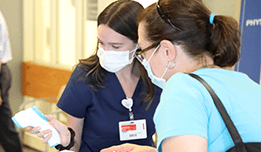Stroke Rehabilitation
After suffering a stroke, you may experience symptoms such as weakness, muscle stiffness, cognitive issues, and/or speech and language problems that make it difficult to manage your daily life. NewYork-Presbyterian has exceptional expertise in stroke rehabilitation. We are devoted to providing advanced rehabilitation services that are not widely available in other centers in the New York metropolitan area, including innovative approaches we have developed to improve the lives of people living with the after-effects of stroke. Our goal is to help you regain as much of your function as possible through personalized, advanced stroke rehabilitation.
Our stroke rehabilitation teams
Our physiatrists (rehabilitation medicine physicians) collaborate with neurologists and neurosurgeons to assess the impact of stroke on your function and to tailor a recovery plan that meets your needs. Physical therapists, occupational therapists, speech/language therapists, recreation therapists, and nurses are all part of our stroke rehabilitation teams. We provide care for as long as you need it, and educate you about ways you can reduce your risk of having another stroke.
Immediate care in the hospital
The sooner you begin stroke rehabilitation, the better your chance of recovery. We begin your rehabilitation as soon as possible after your stroke, beginning at your bedside while you are in the hospital. You may receive physical, occupational, speech/swallowing, and/or recreation therapy.
When appropriate, you can continue acute intensive inpatient rehabilitation in one of our dedicated inpatient units at NewYork-Presbyterian/Columbia University Medical Center or NewYork-Presbyterian/Weill Cornell Medical Center. For individuals requiring subacute rehabilitation, services overseen by our physiatrists are available at the Hebrew Home at Riverdale by RiverSpring Health.
Outpatient stroke rehabilitation
We offer outpatient care directed by our experienced and nationally recognized physicians and delivered by therapists with training in the latest stroke rehabilitation approaches and technologies. Together, your team members are equipped to address issues such as impaired mobility, self-care challenges, cognitive problems (memory, thinking, and word recall), visual problems, and speech and swallowing difficulties.
Robotic therapy for stroke rehabilitation
Robotic devices are an innovative way to provide exercise therapy for people experiencing partial paralysis due to stroke or other neurological condition. Columbia University is a leading center in the development and evaluation of new robotic devices. The team of engineers, physicians, and physical and occupational therapists in the Center for Robotic Rehabilitation (based at both the NewYork-Presbyterian/Columbia and NewYork-Presbyterian/Weill Cornell campuses) works with our patients to find the most effective robotic treatments. We offer robotic therapy with the Amadeo Hand Robot, the Armeo Spring, and the InMotion Shoulder-Elbow and Wrist robotic systems to improve strength and function in the hand, wrist, arm, and shoulder in people who have had a stroke or other neurological disorder. Columbia University engineers and physicians are also developing new devices, such as “MyHand”—a robotic assistive device worn over the hand and forearm which can help stroke survivors regain grasping ability in an affected hand.
Innovative rehabilitation services for stroke survivors
In addition to robotic therapy, several other new approaches have been developed in recent years to improve the use of an arm or leg affected by a stroke.
- Electrical stimulation restores some movement in a weakened limb. We offer the Bioness H200 and L300 and other electrical stimulation devices for the arms and legs.
- Technologies include many of the latest options, such as Saebo therapies and mirror therapy.
- Modified constraint-induced movement therapy consists of intensive exercise of an arm weakened by stroke while the unaffected, stronger arm is restricted.
- Dynamic splinting has been developed for the wrist and hand to mechanically assist stroke survivors in straightening the wrist and fingers.
- Partial body weight-supported treadmill training uses a harness to reduce the amount of weight a stroke survivor bears through the legs, and combines this with practice walking on a treadmill. You may be able to have this therapy if you are early in your recovery and are having difficulty regaining walking ability.
- Acupuncture has long been used to treat a variety of stroke symptoms, including weakness. This treatment is available through Integrative Health and Wellbeing at NewYork-Presbyterian.
- Mental practice involves imagining movement of the affected limb, usually the arm. An audio recording is used to help you focus on the therapy. It may be combined with modified constraint-induced movement therapy for added benefit.
Participate in stroke research
Our team conducts a variety of studies evaluating new treatments for stroke, such as novel therapies for leg weakness and foot drop. These studies have the potential to improve the lives of stroke survivors around the world. You may have the opportunity to participate in a clinical trial of a new therapy.
The Stroke Research Registry contains the names of people who have had a stroke and would like to be informed about the research studies available at NewYork-Presbyterian. By putting your name in our registry, you may be able to participate in one or more of our projects at NewYork-Presbyterian/Weill Cornell or NewYork-Presbyterian/Columbia. Sign up for the registry.
Be a Stroke Warrior
Stroke Warriors is a bilingual stroke support group sponsored by NewYork-Presbyterian/Columbia’s Stroke Division. The group offers guest speakers, Q&A sessions, and resources for stroke survivors, friends, families, and anyone else who has been affected by stroke.



